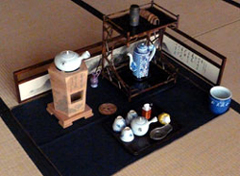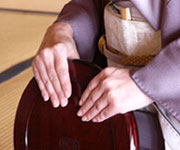公益財団法人 清風苑
Sencha
The Japanese traditional tea ceremony has two genres; with "Matcha" green tea powder, and with "Sencha" green tea leaves.
Both were imported from China and have been developed into an originally Japanese culture.
Japanese people accepted these green teas not only as a drink but also as a cultural element.
So it might not be too much to say that these two tea ceremonies form a main part of Japanese traditional culture.
The green tea leaves, Sencha, came to Japan in the 17th century, as Chinese culture of the Ming Dynasty.
It was by the grace of the Chinese Buddhist monk Ingen Ryuki, founder of Mampukuji-temple in Uji (Kyoto), that brought a new integration of Chinese culture into Japan.
 Sencha was mainly accepted by Zen monks and cultivated people like painters, teachers and poets.
Sencha was mainly accepted by Zen monks and cultivated people like painters, teachers and poets.
So Sencha became not only a drink but an originally Japanese culture with artistic aspects.
There are many elements of the tea ceremony which Japanese people still use naturally today in their every life.
Examples include pottery, calligraphy, stationery, Bonsai (miniature potted trees), flower arrangement and Kaiseki meals.
We cannot doubt that Sencha played an important part in the development of Japanese culture.
Sencha culture flourished the most in the second half of 19th century, and we conserve many Sencha artifacts and data from this period.
Having Sencha became quite natural in the everyday life of many people, and it continues today.
We would be very happy if you learn the traditional Sencha culture from our archives.
We would also be very pleased if the original materials that we preserve inspire you to a more enriched life.
Reishiki
 As we see in the name, Kofu Sencha Reishiki tea ceremony school respects highly Reishiki (manners), but they should not be too strict.
As we see in the name, Kofu Sencha Reishiki tea ceremony school respects highly Reishiki (manners), but they should not be too strict.
Reishiki also can help us to navigate things smoothly in everyday social life.
To do it, we need to be considerate and thoughtful of others. This compels us to enrich our own personality.
The Kofu school regards as the most important thing, to practice manners not only at the tea ceremony time but also in everyday life.
Sencha ceremony and utensils
In the green tea leaf (Sencha) ceremony, we use many sorts of utensils and each has a specific meaning and specific way to be used. Some of them are used even in everyday life.
Seeing these utensils, we understand the extent that the Sencha ceremony influenced Japanese culture, arts and everyday life.
It is possible to discover the historical role of Sencha ceremony utensils.
And, you'll see their beauty; a harmonious balance of functionality and appearance.
Copyright c 公益財団法人 清風苑(Seifuen) All Rights Reserved





